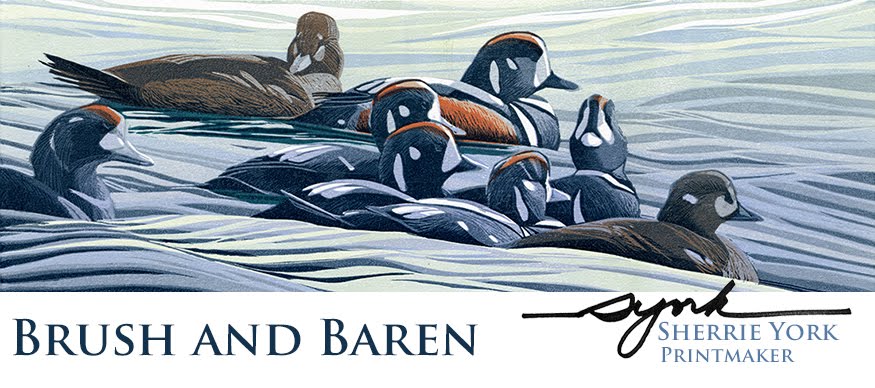But that just means it's time for another chapter of What's it All About Wednesday! Today's lino: Gaining Ground.
 |
| "Gaining Ground," reduction linocut, 9" x 6" Edition of 20 |
Since I'm headed to Maine (in three weeks! ack!) it seemed natural to take a look at one of the most engaging bird species of the northern Atlantic coast: Puffins!
Long-time Brush and Baren readers will know that since 2008 I've spent part of each summer as an instructor and Artist-in-Residence program coordinator at Hog Island Audubon Camp in Maine. Originally envisioned as a place for teachers to come and learn about nature, the camp opened in 1936 with such luminaries as Roger Tory Peterson heading up the staff.
Fast forward to 1969, when a young biologist named Stephen Kress joined the camp's instructional team. Surprised to learn that Maine's coastal islands had once been home to the nearly-extirpated Atlantic puffin, Steve wondered if there were a way to bring the birds back to their former breeding grounds. It was a question which led to the launch of Project Puffin in 1973 and subsequently to the development of seabird conservation techniques that today are employed around the world.
Project Puffin and Hog Island Audubon Camp remain closely connected, and one of the highlights of every camp session is a boat trip to Eastern Egg Rock to see puffins at the site of their first successful reintroduction.
The puffin in "Gaining Ground" is one of Egg Rock's current residents. The title refers both to this individual's waddle towards the highest point of rock, and to the slow but steady increase in the Maine puffin population overall.
While it's wonderful to celebrate the successful return of the species to its historic breeding grounds, we can't just wipe our hands, pat ourselves on the back, and walk away.
In 2012 the northeastern US experienced its warmest March on record, and temperatures remained high throughout the breeding season. The Gulf of Maine is heating up faster than almost any other marine environment on earth, and warmer waters mean changes in available food species. A water temperature rise of just 3 degrees meant puffin parents couldn't find enough small, slim, cold-water hake or herring to feed their chicks. Instead, they found warm water butterfish... which are too fat and round for chicks to swallow. Only 31% of Maine puffin chicks survived to fledging in 2012. The others starved to death with fish at their feet.
The long-term future of puffins in the Gulf of Maine remains uncertain. Good fisheries management has led to increases in the population of the once-endangered Acadian redfish... a good food source for puffins. But the continuing volatility of ocean temperatures can lead to disaster at any moment.
Perched at the border of the US and Canada, Machias Seal Island hosts the largest puffin breeding colony in the Gulf of Maine– 5,500 pairs. But locally warmer surface temperatures in 2016 again created a lack of sufficient food, resulting in almost complete nest failure across the colony.
Monitoring, protecting, and researching the lives of puffins and other seabirds helps us understand the larger changes in our environment, and I am proud of the efforts of my friends and colleagues at Project Puffin and other research projects across the globe. Of course puffins are fun subject matter for a linocut, but for me part of the joy of creating this piece was celebrating the hard work and dedication of biologists everywhere. Thank you all!






